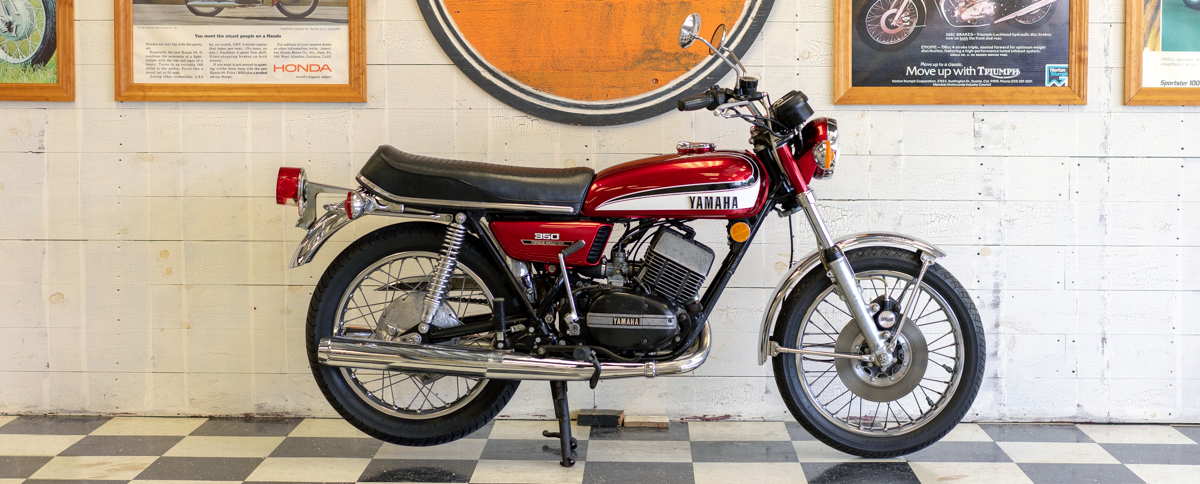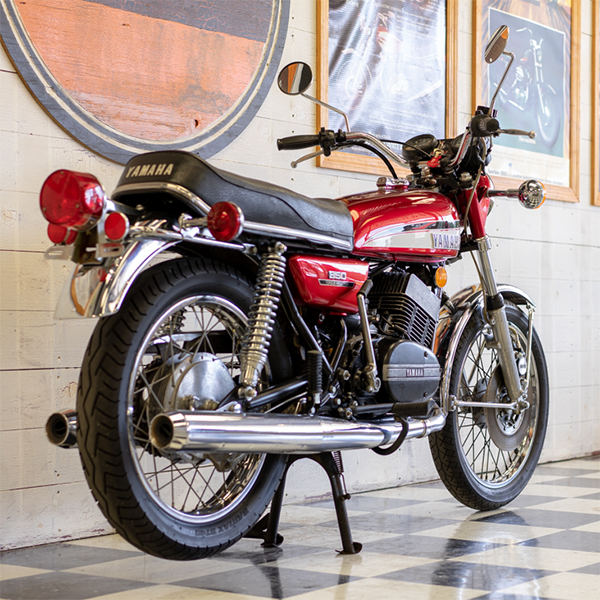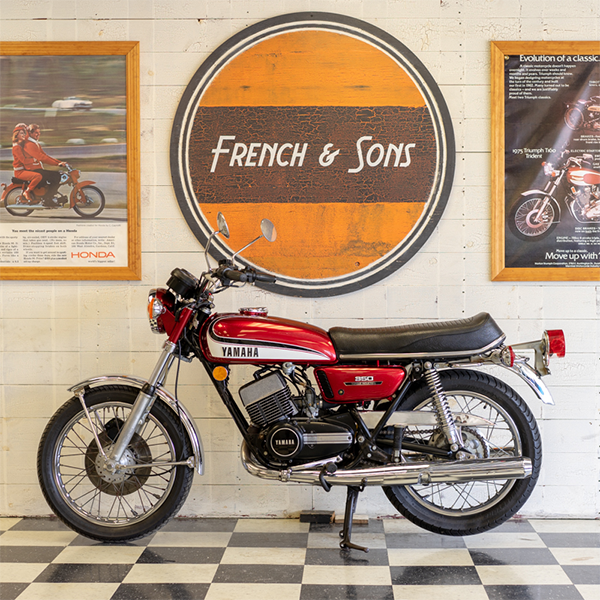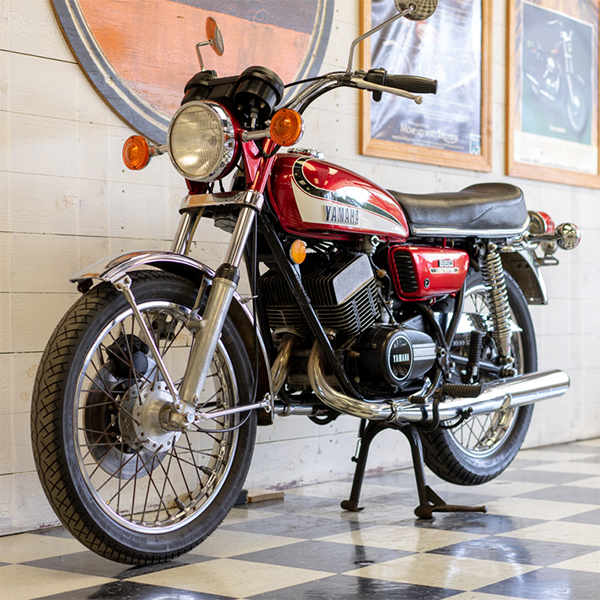Yamaha RD350
Reed Valve Induction, A Disc Front Brake And A Six-Speed Gearbox Add Class To An Already Superb Machine.

THE NEW YAMAHA RD 350 might well be termed the brother of the giant killer if it were compared to its stablemate, the TR3.
Racing versions of the RD 350 have successfully trounced machines over twice their size in AMA Class C competition for the past several years with such regularity that you know it couldn’t be a mistake.
Many features of the new RD 350 have come as a direct result of Yamaha's participation in road racing, both in the United States and abroad, proving that there is truth in the adage "racing improves the breed."
The RD 350 is a cafe racer's delight with its sli1n, sleek styling, disc brake on the front wheel and a closely-spaced six-speed transmission. It also appeals to the daily commuter who rides his motorcycle back and forth to work. Its light weight and nimble handling characteristics make it an ideal vehicle for con1bating the traffic ja1ns found in so n1any of today's cities.
Or take the RD 350 out on a favorite stretch of hilly, winding road where the six-speed transmission and powerful front disc brake can be used to their fullest and you'll find a race-bred motorcycle in a street machine’s clothing.
Here is where we find out what a motorcycle can do. Accelerate rapidly to a certain speed, decelerate by use of the brakes, swoop through a series of turns at a good angle of lean without dragging the side or center stand. This is where the RD 350 excels.
High speed turns exhibited the bike's near neutral handling characteristics with little tendency to oversteer when the power was applied. It had no tendency to plow or turn in on itself in slow turns. It felt as though the Yamaha was on rails, the rear wheel faithfully following the line taken by the front wheel. These are the same fine characteristics we found on the RS that we tested a couple of years ago.
Aside from the reed valve induction system and the six-speed transmission the RD 350 is almost a carbon copy of last year's RSD. The narrow crankshaft assen1bly is supported by four hefty ball bearings and a labyrinth seal separates the two crank chambers. Roller bearings support the connecting rods at the bottom and needle bearings are employed at the small ends to carry the two-ring pistons.
Like most Japanese two-stroke Twins, the RD 350 requires several kicks with the choke full on to get it running and then a minute or so warm-up before setting off on a ride. Snick the short-throw gear lever down into first gear, release the clutch and you're off on a ride that closely approximates the ride on a road racing machine.
Even though the new transmission has six speeds, first and sixth gears provide almost the same reductions as did the older first and fifth gears. The RD 350 pulls well from about 3500 rpm to 8000 rpm which makes it seem unnecessary to have an extra gear. But the joy obtained from riding an RD 350 with its closely spaced gears is worth the extra trouble Yamaha went to. Shift lever throw is short and positive, and the gearbox is very quiet in operation.
Of special interest is the reed valve induction system, called Torque Induction by Yamaha. In this system an additional seventh port is present and is really just an upward extension of the inlet port. The reed valve unit is located in the original inlet tract and opens as long as there is a demand for a fresh fuel/air charge, hence there is less chance of fuel being wasted by too great a throttle opening in relation to the engine's rpm or from blow-back through the carburetor because of too low an engine rpm for a particular throttle opening.
Peak horsepower of the RD 350 is up to 39 bhp as opposed to 36 bhp for last year's RSC. The RD 350 also got slightly better gas mileage than the first RS.
Oil for lubricating the engine's internals comes from a tank located under the right-hand side of the seat and is metered by the Autolube pump. This pump works off the end of the crankshaft and meters the engine's oil according to the crankshaft rpm and the throttle opening. As the throttle is opened when clin1bing a hill the pump's output is increased, but when cruising on level ground or descending a hill, the pump's delivery is cut down accordingly to keep the engine from loading up with unburned oil.
Even though the RD 350 is not what we would call a full-sized motorcycle, the riding position proved quite comfortable to all our staff members for a short ride around town, but really more comfortable to the shorter ones.
If we were grading the suspension, it would get an "A" for road holding and a "B" for comfort. The seat is a little hard and the front forks and rear suspension members are too firm for the Cadillac ride. But it's hard to combine this kind of handling with armchair comfort, and this firmness adds to the feeling of confidence you get when flicking the RD 350 from side to side in an exciting set of bends. Stability is first rate and the rebound damping of both the front forks and the rear shocks seemed just right.
The excellent brakes were also part of the RD 350's charm. Although greatly overshadowed by the fadeless stopping power of the 10.5 in. disc on the front wheel, the rear drun1 brake performed well and only faded slightly during our 60-0 mph stopping tests. The front brake features a double acting caliper unit in which both pads are forced into the disc to perform the braking operation, rather than the earlier design where only one pad n1oves and the caliper floats into alignment when the brake is used.
A handsome instrument panel encases the tachometer, speedometer, turn signal indicators, high beam indicator light and a light that comes on when the brake light is activated. This lamp merely tells the rider when his brake light isn't working and although we felt it was annoying at first, we realize that it is an important safety feature. An "off-run -off' switch is located on the right handlebar and a flick in either direction will stop the engine should trouble arise.
Much of the RD 350's sure-footedness comes from the double cradle frame, which bears a strong rese1nblance to the TR series racing machines. Additional bracing and gussets in highly stressed areas like the steering head and swinging arm pivot points aid in making the RD 350 the handler that it is.
We liked the appearance of the engine/ transmission unit which is finished in a dull black with the fin edges and heightened portions highly polished to accent the classic design lines. This dull black finish also serves to dissipate heat and adds an air of authority to the unit.
We also liked the vane-ty pe steering damper which fits below the bottom triple clamp. It adds just the right amount of drag to help steady the front end when traversing bumpy corners at speed.
Another nice touch is the locking gas filler cap which is unlocked by the ignition key. This will keep the curious little guy down the street from dumping a handful of gravel in your gas tank when you won't take him for a ride!
The RD 350 fills the bill in many respects. Few are the enthusiasts who would want to journey from coast to coast on one, but the short haul commuter and the inveterate cafe racer will love it.
The RD 350 has its parallel in the automotive world-the Datsun 2402. Like that popular medium-priced sports car it offers a combination of two winning features: devastating performance and excitement at a moderate price, and the seemingly contradictory promise of appliance-like reliability.
The enthusiast who wants a taste of that elusive racing quality without the more odious tasks of maintenance which sometimes seem to go with it would do well to try the RD 350.



Specifications
| General | |
|---|---|
| List Price | $839 |
| Chassis | |
| Test weight(w/half-tank fuel) | 344 lb. |
| Weight distribution: front/rear, percent: | 45/55 |
| Fuel capacity | 3.2 gal. |
| Wheelbase | 52.5 in. |
| Handlebar width | 29 in. |
| Seat height | 30 in. |
| Seat width | 9.5 in. |
| Footpeg height | 12 in. |
| Ground clearance | 7.0 in. |
| Suspension/Brakes/Tires | |
| Suspension: Front Rear |
telescopic fork swinging arm |
| Tires: Front Rear |
3.00 x 18 in. 3.50 x 18 in. |
| Brakes: Front Rear |
diameter x width, in. (2) 10.5 x 1.85 diameter x width, in. 7.08 x 1.37 |
| Brake loading (160 lb. rider) | 5.9 |
| Engine/Gearbox | |
| Engine | two-stroke Twin |
| Bore x stroke | 64 x 54mm |
| Displacement | 347cc |
| Compression ratio | 6.8:1 |
| Carburetion | (2) Mikuni VM 28mm SC |
| Air filter | treated dry paper |
| Ignition | coil & battery |
| Claimed power | 39 bhp@ 7500 rpm |
| Claimed torque | 28.0 lb.-ft. @7000 rpm |
| Lubrication | oil injection |
| Oil capacity | 4.2 pt. |
| Electrical power | 12v alternator |
| Starter | primary kick |
| Primary drive | helical gear |
| Clutch | multi-disc, wet |
| Final drive | single-row chain |
| Gear ratios, overall:1 6th 5th 4th 3rd 2nd 1st |
6.00 6.80 7.96 10.08 13.60 19.67 |
| Performance | |
| Acceleration Time to distance: ¼ mi. Time to speed, sec. 0-30 mph 0-40 mph 0-50 mph 0-60 mph 0-70 mph 0-80 mph 0-90 mph |
14.30 sec. @ 89.82 2.9 3.6 4.7 5.9 7.1 9.8 14.4 |
| Speed in Gears Measured top speed in ½ mi. Calculated at 8000 rpm: 1st gear 2nd 3rd 4th 5th 6th |
99 mph 30 mph 43 mph 59 mph 74 mph 87 mph 99 mph |
| Fuel Consumption | 40 mpg |
| Braking Distance from 30 mph from 60 mph |
29 ft. 122 ft. |
| Speedometer Error 50 mph indicated 60 mph indicated 70 mph indicated |
46 mph 56 mph 65 mph |